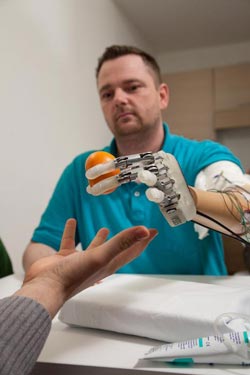Prostheses with Sensory Feedback

The patient Dennis Aabo Sorensen grasps at a mandarin orange with his artificial hand. Source: LifeHand2 Project <br>
The patient Dennis Aabo Sorensen grasps at a mandarin orange with his artificial hand. Source: LifeHand2 Project
An artificial limb that enables amputees to grasp at an object and feel it as though they were using their real hand: Thanks to Freiburg microsystems engineer Prof. Dr. Thomas Stieglitz and the international research group participating in the project LifeHand2, this has now become a reality. The scientists present the findings of their project in the journal Science Translational Medicine.
Surgeons implanted two ultra-thin electrodes each directly into the ulnar and median nerves in the upper arm of Dennis Aabo Sørensen, a patient with an amputated lower arm. The electrodes send sensory data by means of electrical impulses from the patient’s artificial hand directly to his brain over the peripheral nervous system. They give him information about the shape and consistency of the objects he grasps at – even when he cannot see them.
The patient learned to control his artificial hand with only little prior training and more quickly than the scientists had thought possible. He managed to sense objects like a plastic cup, a mandarin orange, and a heavy block of wood while being blindfolded and to take hold of them with a precise grip and the right amount of force. The combination of technology and the patient’s biological system worked almost intuitively.
The electrodes were developed in Thomas Stieglitz’ laboratory, professor of Biomedical Microtechnology at the Department of Microsystems Engineering of the University of Freiburg. “Our research helps patients who have lost a limb to move their prostheses in a completely natural way. It is always a very special moment for me as an engineer to see technological developments be implemented successfully on a patient after many years in the lab,” said the researcher. As this was only an initial test, the electrodes will have to be removed after 30 days as per the European directive on medical devices. The team plans to conduct further studies on patients in Rome, Italy; Lausanne, Switzerland; and Aalborg, Denmark.
Six research institutions in Italy, Switzerland, and Germany are participating in the project LifeHand 2. Launched in 2008, the project originated from the European Union–funded project TIME and the Italian project NEMESIS. The clinical director of the study is Prof. Dr. Paolo Maria Rossini, and the operation was performed by Prof. Dr. Eduardo Marcos Fernandez. Both are from the Agostino Gemelli University Polyclinic in Rome. The project director is Prof. Dr. Silvestro Micera from the Swiss Federal Institute of Technology in Lausanne.
Original publication
S. Raspopovic, M. Capogrosso, F. M. Petrini, M. Bonizzato, J. Rigosa, G. D. Pino, J. Carpaneto, M. Controzzi, T. Boretius, E. Fernandez, G. Granata, C. M. Oddo, L. Citi, A. L. Ciancio, C. Cipriani, M. C. Carrozza, W. Jensen, E. Guglielmelli, T. Stieglitz, P. M. Rossini, S. Micera, Restoring Natural Sensory Feedback in Real-Time Bidirectional Hand Prostheses. Sci. Transl. Med. 6, 222ra19 (2014). http://stm.sciencemag.org/content/6/222/222ra19
Further information on Surprising Science:
www.pr.uni-freiburg.de/go/lifehand2
Film and photo material available on request.
Contact:
Prof. Dr. Thomas Stieglitz
Laboratory for Biomedical Microtechnology
Department of Microsystems Engineering (IMTEK)
Phone: +49 (0)761 / 203-7471
E-Mail: thomas.stieglitz@imtek.uni-freiburg.de
Natascha Thoma-Widmann
PR/Marketing Coordinator
Faculty of Engineering
University of Freiburg
Phone: +49 (0)761 / 203-8056
Mobile: +49 (0)171 / 7616720
E-Mail: thoma-widmann@tf.uni-freiburg.de
Media Contact
All latest news from the category: Information Technology
Here you can find a summary of innovations in the fields of information and data processing and up-to-date developments on IT equipment and hardware.
This area covers topics such as IT services, IT architectures, IT management and telecommunications.
Newest articles

A new look at the consequences of light pollution
GAME 2024 begins its experiments in eight countries. Can artificial light at night harm marine algae and impair their important functions for coastal ecosystems? This year’s project of the training…

Silicon Carbide Innovation Alliance to drive industrial-scale semiconductor work
Known for its ability to withstand extreme environments and high voltages, silicon carbide (SiC) is a semiconducting material made up of silicon and carbon atoms arranged into crystals that is…

New SPECT/CT technique shows impressive biomarker identification
…offers increased access for prostate cancer patients. A novel SPECT/CT acquisition method can accurately detect radiopharmaceutical biodistribution in a convenient manner for prostate cancer patients, opening the door for more…





















